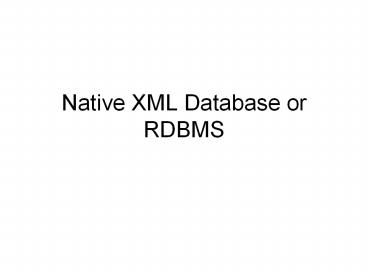Native XML Database or RDBMS - PowerPoint PPT Presentation
Title:
Native XML Database or RDBMS
Description:
Native XML Database or RDBMS Data or Document orientation If you are primarily storing documents, then a Native XML Database may be the best option. – PowerPoint PPT presentation
Number of Views:113
Avg rating:3.0/5.0
Title: Native XML Database or RDBMS
1
Native XML Database or RDBMS
2
Data or Document orientation
- If you are primarily storing documents, then a
Native XML Database may be the best option.
However it will depend on document structure and
on the kinds of questions you need to ask about
the information / data that the documents
contain.
3
Native XML Database
- If primarily storing and querying the content of
documents, especially with - varying structure.
- mixed content
- recursive content
- complex mix of elements and attributes
- Documents best encoded handled with XML
- If you have lots of different XML datatypes and
schema or you have lots of well-formed XML to
deal with, the native XML DBMSs make it much
easier to efficiently store and retrieve
well-formed XML.
4
RDBMS
- If you are primarily storing data or
data-oriented documents (primarily of interest to
an application) then mapping documents into
relations may be appropriate where there is - clear metadata
- head-body structure primarily queried on metadata
(which tends to be fixed structure) - a simple schema - otherwise you get
- lots of tables, complex query joins and slow
access times - few tables and lots of null column entries which
need complex interpretation - If you have a small number of XML schema to work
with, are able and prepared to design appropriate
storage strategies and to build data loading
programs, an XML-enabled RDBMS may be
satisfactory.
5
- Importing and Exporting XML to/from MSAccess
- http//msdn.microsoft.com/library/default.asp?url
/library/en-us/dnacc2k2/html/odc_accessxml.asp - Oracle9i SQL/XML
- http//www.oracle.com/technology/oramag/oracle/03-
may/o33xml.html - Native XQuery engine integrated with Oracle
Database 10g Release 2. - http//www.oracle.com/technology/pub/articles/vasi
liev_xquery.html
6
Complexity of queries
- The ways in which information will be queried is
an important factor. - Retrieval / manipulation of structured data --
RDBMS - Full-text searching, or manipulating a recursive
content model --Native XML Database or XML
enabled Database with an appropriate XML query
language - e.g. bill of materials or build configuration
queries are difficult for SQL, but
straightforward in XPath
7
Existing investment
- DBMS
- Existing applications and data resources
- Tools and add-ons
- report generators
- forms
- Skill-sets
- 3NF
- SQL
- Experience of existing environment
8
Relative Cost
- If you have a heavy investment in an
Object-Relational DBMS their XML add-on support
may be appropriate. If you are starting from
scratch, the Native XML DBMSs are generally
cheaper, lighter, and easier to manage.
9
Data integrity
- Referential integrity is at the core of the
relational model. - In XML the concept of integrity is less well
defined and application code will be required to
maintain integrity. - If there is a strong requirement for data
integrity, then a relational or XML enabled
database may be the better solution. - When mapping an XML document into a relational
database (if you're not using a BLOB to store the
whole document), some information about the
document will be lost. If you require that data
must retain its original structure, into and out
of storage, then an Native XML Database is the
best solution.































